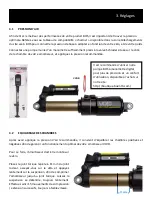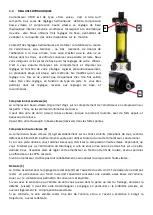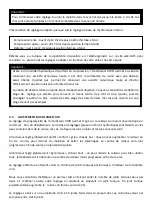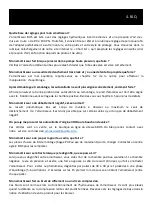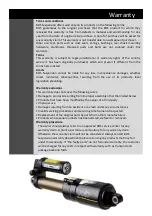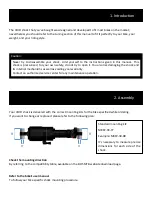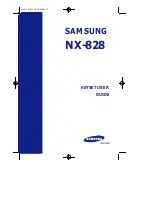
3.4
HYDRAULIC SETTINGS
The VOID shock is a three-ways adjustable shock, which means there are
three different damping adjustments: rebound, low-speed compression,
high-speed compression.
Your shock’s base setting (internal) is set up for your bike’s geometry
when you purchase the shock. We use three basic settings which cover
the majority of bikes on the market.
The purpose of damping adjustments is to use all the shock’s travel
without bottoming-out (or only very occasionally), to give rear wheel grip,
but also to avoid the bike stalling out in holes, and finally to maintain a
good chassis position.
Below you will find the base settings for your shock, then it’s up to you to
analyze its performance on the trail and tune the settings to suit your
riding style. Do this carefully and methodically, step by step. Only change
one setting at a time and only by a few clicks. When it’s done, note the
setting and type of terrain.
If you get confused with the settings, return to the base settings and start
again.
Low-speed compression (A)
The low-speed compression (A) affects the shock’s performance in compression over small bumps or
through the beginning of the travel.
Harden the low-speed compression (by turning the knob clockwise) on rolling terrain with big
compressions and kickers.
It might be useful to soften the low-speed compression (by turning the knob counter-clockwise) on steep
gradients.
High-speed compression (B)
The high-speed compression acts mainly on harsh hits (jump landings, rough sections). It should be soft
enough to get all the travel without bottoming-out. If, on a given track, you bottom-out frequently, harden
the high-speed compression by turning the knob clockwise. However, don’t get hung up on bottoming-out
if it only happens once or twice during your run. You risk setting your shock for 3% of the course and losing
efficiency on the other 97%.
If your shock doesn’t get full travel, soften the high-speed compression by turning the knob to counter-
clockwise.
Rebound (C)
The main factor in adjusting the rebound is the position of the bike. A bike shouldn’t be “sunken down” all
the time, although the back does need to be fairly low. Adjusting the rebound will allow you to maintain
this balance.
If you feel like the back of the bike is pushing you forward on a slope or when braking, slow down the
rebound (turn the knob clockwise). It can be useful to go along with this adjustment (especially if the
problem persists) by slightly soften the low-speed compression.
However, if the bike seems too low at the back and/or the front end has a tendency to drift offline, speed
up the rebound
A
B
C
Summary of Contents for VOID2
Page 1: ...VOID Notice D utilisation ...
Page 13: ...VOID User Manual l ...

